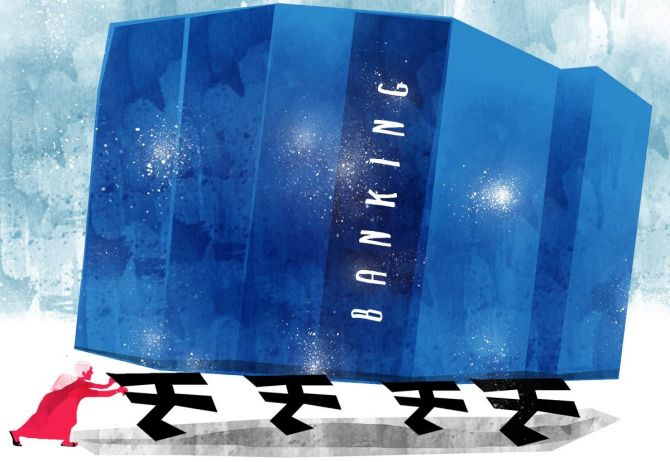The drop in net interest margin will separate the men from the boys, explains Tamal Bandyopadhyay.

Posting record profits has become a habit for Indian banks. With every quarter, their performance is getting better.
Except for two private banks -- Yes Bank Ltd and Bandhan Bank Ltd -- and one public sector bank, Punjab National Bank, all listed banks have posted a handsome rise in net profits in the December quarter.
For India's largest lender, the State Bank of India, the Rs 14,205 crore (Rs 142.05 billion) net profit is the highest-ever quarterly profit in its history.
Four PSBs -- Bank of Maharashtra, UCO Bank, Union Bank of India and Indian Bank -- have more than doubled their profits compared with the year-ago quarter.
Even relatively larger banks such as Bank of Baroda and Canara Bank have ramped up their net profits by 75 per cent and 92 per cent, respectively.
The scene is no different for private banks. Smaller banks such as Dhanlaxmi Bank Ltd, City Union Bank Ltd and Karnataka Bank Ltd have recorded a stiff rise in net profits.
IDFC First Bank Ltd has more than doubled its net profit and the jump in Axis Bank Ltd's net profit is 62 per cent.
The net profit of 20 listed private banks is Rs 36,357 crore (Rs 363.57 billion) and that of 12 PSBs Rs 29,175 crore (Rs 291.75 billion), taking the net profit of all listed banks to a record high of Rs 65,532 crore (Rs 655.32 billion) in the December quarter.
The comparable figure in December 2021 was Rs 44,915 crore (Rs 449.15 billion) and, in the preceding September 2022 quarter, Rs 58,113 crore (Rs 581.13 billion).
Barring four private banks -- Bandhan Bank, DCB Bank Ltd, RBL Bank Ltd and South Indian Bank Ltd -- all have recorded a rise in operating profits.
For the pack, the growth has been 30.45 per cent to a record Rs 1.27 trillion.
The main contributing factors to the record profits are higher net interest income (NII) and lower provisions for bad assets.
Except for Bandhan Bank (which has shown a 2.09 per cent drop in NII) and Punjab & Sind Bank (which has shown a meagre 6.25 per cent rise), all banks have shown healthy double-digit growth in NII.
ICICI Bank Ltd, Axis Bank, Kotak Mahindra Bank Ltd and Yes Bank, along with a few small old private banks, have posted at least 30 per cent rise in NII.
Both HDFC Bank Ltd and SBI have recorded more than 24 per cent rise.
The growth in NII for the industry is close to 26 per cent.
Relatively, the rise in other income, which includes income from treasury, has been muted. Quite a few banks have, in fact, shown a drop in other income.
As fresh slippages have been arrested and the pile of bad loans is shrinking, the growth in provisions is in single digit.
In fact, quite a few banks including SBI, Bank of Baroda, HDFC Bank, Kotak Mahindra Bank and IndusInd Bank Ltd have shown a decline in provisions.
Overall, private banks' provisions in the December quarter have risen by 7.67 per cent and those of PSBs 10.34 per cent.
In absolute terms, except for HDFC Bank, all banks have shown a drop in their gross non-performing assets (NPAs).
When it comes to net NPAs, HDFC Bank and IndusInd Bank have shown a marginal rise. The rest have shown a decline in their bad loans.
The private banks' gross NPAs is a little over Rs 1.46 trillion in December 2022, 25 per cent less than the year-ago quarter.
The comparable figure for the PSBs is around Rs 4.58 trillion, recording an 18 per cent drop.
After making provisions, the net NPAs of private banks in December is Rs 33,091 crore -- a decline of 34.32 per cent.
The drop in the PSB net NPA portfolio is 31.34 per cent, at Rs 1.15 trillion.
The listed banks have Rs 6.05 trillion gross NPAs and Rs 1.48 trillion net NPAs.
At their peak, in March 2018, the gross NPAs of all scheduled commercial banks (listed banks plus others) were Rs 10.4 trillion and net NPAs Rs 5.2 trillion.
The PSBs' gross NPAs were Rs 8.96 trillion then and net NPAs Rs 4.54 trillion; and private banks' gross NPAs were Rs 1.29 trillion and net NPAs Rs 64,000 crore.
Their gross NPAs peaked in March 2020 -- Rs 2.1 trillion.
In percentage terms, almost every bank has brought down its gross and net NPAs in December, both sequentially as well as quarter-on-quarter.
There are two exceptions -- HDFC Bank (1.23 per cent of advances) and Tamilnad Mercantile Bank (1.7 per cent).
The figures remained unchanged between the September and December quarters.
Yes Bank's gross NPAs were sharply down from 12.89 per cent in September to 2.02 per cent in December.
A year ago, these stood at 14.65 per cent.
The bank transferred Rs 48,000 crore bad loans to private equity firm JC Flowers to clean up its balance sheet.
Among private banks, IDBI Bank Ltd continues to have the maximum gross NPAs (13.82 per cent), followed by Bandhan Bank (7.15 per cent).
Among PSBs, PNB tops the list with 9.76 per cent gross NPAs.
Bank of Maharashtra has the lowest gross NPAs (2.94 per cent), followed by SBI (3.14 per cent).
After provisioning, net NPAs, as a percentage of advances, have come down in the December quarter for all listed banks -- both quarter-on-quarter as well as sequentially -- barring HDFC Bank and Bandhan Bank.
The net NPAs of these two banks have remained 0.33 per cent and 1.86 per cent in the December quarter, respectively, unchanged from the September quarter.
Except for Jammu & Kashmir Bank Ltd, South Indian Bank Ltd and City Union Bank Ltd, all listed private banks have less than 2 per cent net NPAs and quite a few of them, including Axis Bank, ICICI Bank Ltd, IndusInd Bank and Kotak Mahindra Bank, besides HDFC Bank, have far less than 1 per cent net NPAs.
Among PSBs, SBI, Bank of Baroda and Bank of Maharashtra have less than 1 per cent net NPAs. PNB has the highest (3.3 per cent).
At its peak, in March 2018, the banking system's gross NPAs were 11.2 per cent.
Post-provisions, the net NPAs were 6 per cent.
The PSBs' gross NPAs were 14.6 per cent and net NPAs 8 per cent in 2018.
The private banks' gross NPAs were 4.7 per cent and net NPAs 2.4 per cent.
Their gross NPAs rose to 5.5 per cent in March 2020.
Most banks have ramped up their provision coverage ratio (PCR) to strengthen their balance sheets.
Barring Yes Bank, which has 49.4 per cent PCR, most have at least 70 per cent or even more. IDBI Bank has 98 per cent PCR and seven of the 12 PSBs have at least 90 per cent PCR.
For most banks, year-on-year credit growth has been in double digits (a few have seen at least 20 per cent growth) but the deposit growth is lagging. Therein lies the catch.
As the war for deposit intensifies, banks' net interest margin (NIM) will be under pressure and they won't be able to keep the momentum.
Banks have been raising their loan rates -- either linked to an external benchmark or the marginal cost of fund-based rate -- as well as deposit rates.
But while the new rates are applicable on all loans, pushing up their income instantly, only the cost of fresh deposits rises.
The banks will start feeling the pressure when a substantial portion of their deposit portfolio gets repriced.
The March quarter could be the last quarter for their almost surreal romance with profits.
From June, the drop in NIM will separate the men from the boys.
Banks have been raising their loan rates -- either linked to an external benchmark or the marginal cost of fund-based rate -- as well as deposit rates.
But while the new rates are applicable on all loans, pushing up their income instantly, only the cost of fresh deposits rises
Tamal Bandyopadhyay, a consulting editor of Business Standard, is an author and senior adviser to Jana Small Finance Bank Ltd.












 © 2025
© 2025